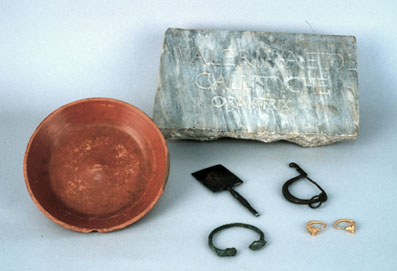

This burial collection**, dating from the second century AD, presents a excellent example of a classic Roman inhumation, in which the body is not burned but buried. This became the favored mode for Roman treatment of the dead from around the time of the second century AD onwards. Along with an ornately carved sarcophagus, the burial contains a set of handcrafted gold earrings, a bronze mirror, a fibula (a brooch used to secure a Roman woman's stola, or dress), a twisted bronze bracelet and a terra sigillata bowl. Near the sarcophagus would have stood an inscription bearing the epitaph: "Valeria Callityche, freedwoman of Aulus and Gaia, a hairdresser."
 The
freedwomen and freedmen of the Roman empire, like the woman entombed in
this sarcophagus, were former slaves who had bought their freedom, or who
had been liberated by the decree of their master or by the master's death.
Often these men and women, though free, would remain in the patronage of
their former owners, but they were not limited to the service of those under
whom they had been enslaved. When freed, these men and women acquired a
higher social status than that which they had held as slaves. The writing
on the grave marker, "freedwoman of Aulus and Gaia," indicates
a possible lasting connection between the woman and her former masters.
This lasting relationship and patronage may have lead to the accumulated
wealth displayed here.
The
freedwomen and freedmen of the Roman empire, like the woman entombed in
this sarcophagus, were former slaves who had bought their freedom, or who
had been liberated by the decree of their master or by the master's death.
Often these men and women, though free, would remain in the patronage of
their former owners, but they were not limited to the service of those under
whom they had been enslaved. When freed, these men and women acquired a
higher social status than that which they had held as slaves. The writing
on the grave marker, "freedwoman of Aulus and Gaia," indicates
a possible lasting connection between the woman and her former masters.
This lasting relationship and patronage may have lead to the accumulated
wealth displayed here.
 The
entombed woman, Valeria Callityche, displayed through her burial an elevated
status and a high standard of living. The golden earrings with which she
was buried were of the highest quality craftsmanship, not something a poor
woman would possess. The beautifully wound golden wire of the earrings culminates
in a depiction of a bull's head, to which the clasp fastens. The bull's
head was a classic style element in the jewelry designs of the time. Animal
and human representations, along with geometric and linear patterns, remained
staples of Roman jewelry for nearly the entire duration of the empire. The
number of items in her grave that reflect a concern with personal appearance
(such as the mirror, earrings,
and bracelet) suggests Valeria Callityche was
concerned to 'look good' in death as in life.
The
entombed woman, Valeria Callityche, displayed through her burial an elevated
status and a high standard of living. The golden earrings with which she
was buried were of the highest quality craftsmanship, not something a poor
woman would possess. The beautifully wound golden wire of the earrings culminates
in a depiction of a bull's head, to which the clasp fastens. The bull's
head was a classic style element in the jewelry designs of the time. Animal
and human representations, along with geometric and linear patterns, remained
staples of Roman jewelry for nearly the entire duration of the empire. The
number of items in her grave that reflect a concern with personal appearance
(such as the mirror, earrings,
and bracelet) suggests Valeria Callityche was
concerned to 'look good' in death as in life.
This display of wealth in death was not necessarily the norm for the freedmen and especially the freedwomen of the Roman empire. The inscription indicates that Valeria Callityche was a hairdresser, a profession that normally would not have garnered the fortune displayed in her burial. Both the richness of the burial goods and the occupation of the deceased woman indicate an outside influence involved in the acquisition of her wealth. Valeria Callityche (whose second name, in Greek, means 'beautiful fortune') may very well have remained in the patronage of her former masters, allowing her to accumulate wealth while being supported and subsidized by the family which once had owned her.
![]() Tour of objects
in the inhumation assemblage**
Tour of objects
in the inhumation assemblage**
**Please note: this "assemblage" was created solely for educational purposes. All of the objects discussed here are from entirely different archaeological contexts. A full explanation of this class project is found on the introductory page for this website.